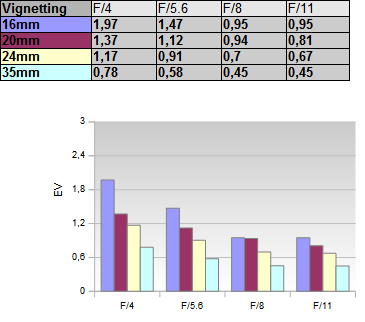|
Carl-Zeiss Vario-Tessar T* FE 16-35mm f/4 ZA OSS ( Sony SEL1635Z ) - Review / Test Report - Analysis |
|
Lens Reviews -
Sony Alpha (Full Format)
|
|
Page 2 of 3

Distortion
As a user you can select whether your images shall be auto-corrected or remain in true RAW mode. In auto-corrected mode, there is, unsurprisingly, nothing to worry about. The distortions stay at sub-0.5% levels which is negligible really. However, the situation changes when looking at the original characteristic of the lens. It shows a rather heavy ~3% barrel distortion at 16mm and moderate pincushion distortion at and beyond 20mm. This is about typical in this lens class though.
If you move your mouse cursor over the image you can switch to the corresponding auto-corrected results (there may be a short delay).
Vignetting
The auto-corrected light falloff at max. aperture is average for an ultra-wide lens on a full format camera. At f/4, we can observe a max. light falloff of almost 2EV (f-stops) at 16mm f/4 but the issue is more moderate at other settings. At medium apertures you can expect a light falloff of around 1 f-stop at the wide end to 1/2 f-stop at 35mm.
 The situation changes when looking at the uncorrected data. At fully open aperture, the falloff is a hefty 3EV at 16mm. Stopping down to f/8 gives you ~1.7EV which isn't great either.
The issues eases the more you zoom towards the long end but it remains high compared to DSLR lenses in this range. It is worth to mention that vignetting is a rather typical weakness of Zeiss lenses in general.
The situation changes when looking at the uncorrected data. At fully open aperture, the falloff is a hefty 3EV at 16mm. Stopping down to f/8 gives you ~1.7EV which isn't great either.
The issues eases the more you zoom towards the long end but it remains high compared to DSLR lenses in this range. It is worth to mention that vignetting is a rather typical weakness of Zeiss lenses in general.

MTF (resolution)
The resolution characteristic varies a bit but it's generally pretty impressive. The center quality is nothing short of outstanding and it's a safe bet to state that it easily exceeds the capabilities of the 36mp sensor at mainstream settings here. In the low to mid range the border quality is also very good to excellent and even the corners are sharp. Unfortunately the 35mm setting isn't quite as impressive. While the center is still fine, and even superb at f/5.6 and f/8, the corners are soft at large aperture settings. However, to be fair - they recover nicely till f/8 so from a real world perspective this may be less relevant. Diffraction has an impact from f/11 onward.
The (focus-)field curvature is quite pronounced at 16mm at f/4 & f/5.6 so the corners can be pushed out-of-focus in real life situations. However, the curvature flattens when stopping down. The effect has decreased significantly at 20mm already. Residual spherical aberrations (focus shifts) are not an issue.
The centering quality of the tested sample was Okay with a slightly higher softness on the left side of the image field.
Please note that the MTF results are not directly comparable across the different systems!
Below is a simplified summary of the formal findings. The chart shows line widths per picture height (LW/PH) which can be taken as a measure for sharpness.
If you want to know more about the MTF50 figures you may check out the corresponding Imatest Explanations
Chromatic Aberrations (CAs)
Lateral CAs can be auto-corrected either by the camera or via various RAW converter. This is a lossless operation so it's a good idea to take advantage of this. However, the Zeiss is quite well corrected - at least when looking at the border zone where the average CA pixel width varies around the 1.5px mark. The figures are somewhat higher in the extreme corners though. Even so this is pretty good for an ultra-wide lens tested on a 36 megapixel camera.

|